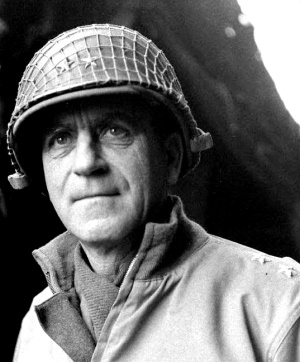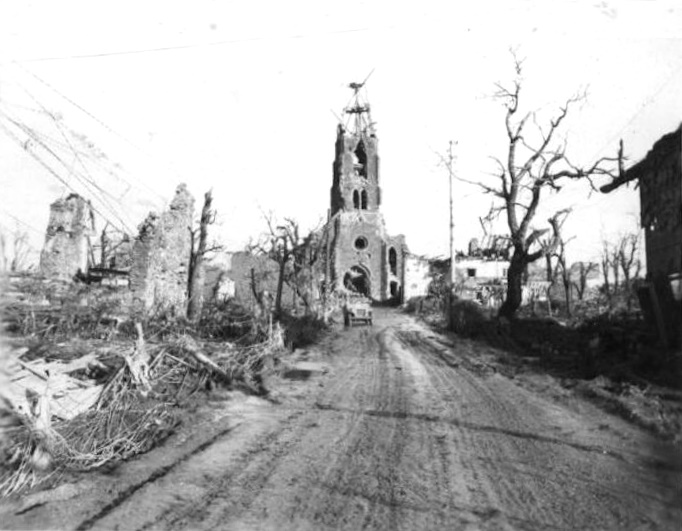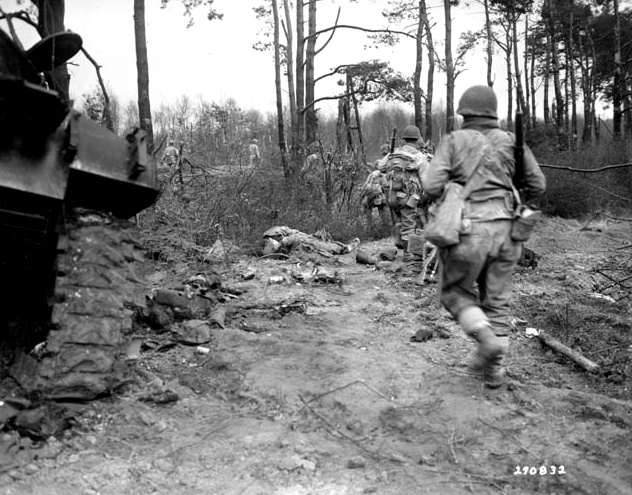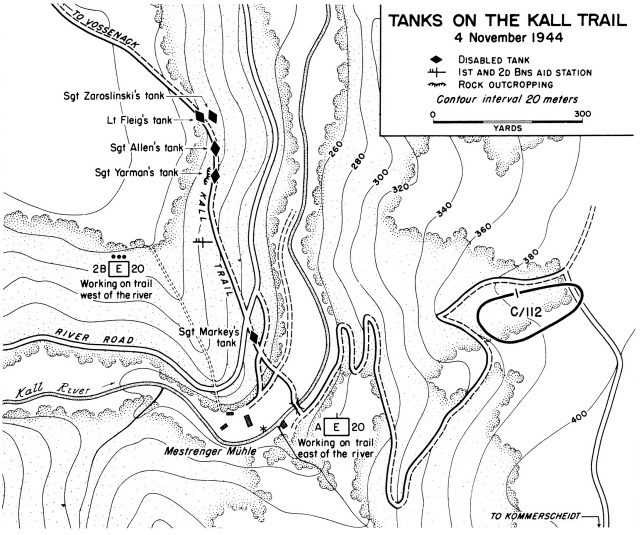Already below full strength, the attacks would be made only by partial units of these elements (Miller, A Dark and Bloody Ground: The Huertgen Forest and the Roer River Dams, 1944-1945, 27). Despite these shortages, the 39-IR proceeded through the gloom and dug in at the Weisser Weh, only to be met by Gen Paul Mahlmann’s German 353.Infantry-Division the next day and then recalled from the valley to help the 47-IR in Schevenhutte, which was under attack by the fresh German 12.Infantry-Division (Gen Gerhard Engel).
The 60-IR ran into machine-gun nests and disguised bunkers, taking heavy losses in what became a raging, close-combat struggle over a few pillboxes. The 39th got to Schevenhutte to find that it wasn’t needed and slogged back through the Weisser Weh only to find that the Germans had set up residence in their old position – their first taste of the confused, disorganized fighting that was to come. The advance, despite reorganizations and changed plans, had stalled in the thick forest. Absent the traditional American accent on air power and artillery, the heavy losses incurred in these pure infantry struggles forced the 9th to stop at the end of September, and Gen Gerow’s V Corps took over some of the VII Corps’ line positions (Margry, “The Battle of the Huertgen Forest”, 8).
Despite what was essentially a failure in the first real incursion into the Huertgen, intelligence officers still felt that should a breakthrough occur, or several penetrations occur, the enemy will begin a withdrawal to the Rhine River, abandoning his Siegfried Line (Neillands, The Battle for the Rhine, The Battle of the Bulge and the Ardennes Campaign, 1944, 240) so General Craig consolidated his troops for a second thrust into the forest, this time toward the village of Schmidt, which sat at the nexus of most of the major roads in the forest. Again, however, he was to attack at nowhere near his full strength, as the 47th Infantry was stuck defending Schevenhutte – so the 39th would take another stab at Germeter on the left, and the 60th would move on the right (Margry, “The Battle of the Huertgen Forest”, 8). They would be opposed by the German 275.Infantry-Division, a hodgepodge of men squeezed together in the peculiar German habit of forming new units from remnants, rather than reinforcing older, depleted units (Miller, A Dark and Bloody Ground: The Huertgen Forest and the Roer River Dams, 1944-1945, 33); the German defenders, with decent defenses and a larger-than-average number of heavy guns per unit, seemed to appear whenever and wherever they were needed – and approximately 6500 of them were beefing up their positions when the 9th came once again at the forest. On October 6, a short artillery barrage and P-47 dive-bomb attacks precluded the 9th’s next attack into the forest.
The 39-IR advanced without a secure northern flank and with inadequate (mostly absent) air cover and regular and repeated attacks so predictable that they were chewed up by accurate German artillery fire called down from observation posts (Gerald Astor, “The Deadly Forest”, World War II (Nov 2004), 27) bogging down under that and fire from well-concealed pillboxes, and stopping a mile from Germeter; the 60-IR was decimated by machine-gun fire and artillery tree-bursts, made it about 700 M before stopping in the wet forest just short of Reichelskaul; commanders were reluctant to proceed without the tank support that couldn’t get to them because of German mines, roadblocks, and narrow, muddy trails (Miller, A Dark and Bloody Ground: The Huertgen Forest and the Roer River Dams, 1944-1945, 38).
By the time the tanks arrived, the 60-IR was hunkered down and barely enduring further German barrages. The 39-IR reached Germeter only on Oct 10, to find it empty – neither Gen Erich Brandenberger (CG 7-A) nor his subordinates could figure out American motives in the forest, but they also could not ignore them, and were forced to shuffle their troops around to offer continual resistance (MacDonald, The Battle of the Huertgen Forest, 63-86-90).
The 39-IR crept toward Vossenack but was outflanked by the German Wegelein Regiment (Oberstleutnant Helmuth Wegelein) just arrived as reinforcements; after 3 days of fighting, the 39th had regained its original positions, and little else. By Oct 16, the 9-ID had slugged it out with its German opposition in the wet, miserable forest, fighting characterized by confused thrusts from one line to another against prepared positions – it had failed to take the town of Schmidt and its vital road net but gained approximately 3000 yards of dense forest that now needed to be held, at the very high cost of about 4500 casualties. It was so depleted that it was no longer combat-effective, but the US 1-A still didn’t have its secure flank – so Gen Hodges, still believing that the forest itself should be taken and held, had to come up with another plan (MacDonald, The Battle of the Huertgen Forest, 63-86-90).
 This plan was strikingly familiar to the old one, with a few changes. First, in personnel, with Gerow’s V Corps now tasked with taking the town of Schmidt, his 28-ID relieved the 9-ID on Oct 26. Second, in armament, as he added tank destroyers, chemical munitions, forty-seven Weasels, extra
This plan was strikingly familiar to the old one, with a few changes. First, in personnel, with Gerow’s V Corps now tasked with taking the town of Schmidt, his 28-ID relieved the 9-ID on Oct 26. Second, in armament, as he added tank destroyers, chemical munitions, forty-seven Weasels, extra  engineers, and artillery, all to support the infantry divisions. Other than a different division with added mechanization, the plan was essentially the same, and attacks would be made with under-strength units with exposed flanks, much to the dismay of Gen Normand ‘Dutch’ Cota, CG of the 28-ID. When his men assumed the 9-ID’s positions, they were greeted with a tableau of dead bodies (human and animals), discarded material, shredded trees, and craters left by artillery shells (MacDonald, The Battle of the Huertgen Forest, 63-86-90); a landscape resembling just like a slaughterhouse on a (tree-filled) moon.
engineers, and artillery, all to support the infantry divisions. Other than a different division with added mechanization, the plan was essentially the same, and attacks would be made with under-strength units with exposed flanks, much to the dismay of Gen Normand ‘Dutch’ Cota, CG of the 28-ID. When his men assumed the 9-ID’s positions, they were greeted with a tableau of dead bodies (human and animals), discarded material, shredded trees, and craters left by artillery shells (MacDonald, The Battle of the Huertgen Forest, 63-86-90); a landscape resembling just like a slaughterhouse on a (tree-filled) moon.
Adding to his frustration was the fact that his men were now committed to the same plan of attack that gave birth to such a place, and with the same meager military resources and limited operational freedom – between the limiting terrain and the plan he was ordered to follow, he had little leeway. Cota’s men would first have to fight uphill through the woods to get to the few roads that existed, as they were on the exposed ridges overlooking the Kall River, and no one was sure if any of the mechanized pieces (tanks, tanks destroyers, artillery pieces) could even get through the woods to face German armor, which had the luxury of roads leading into their side of the valley. Thus reinforced, the 28-ID was to push toward Schmidt as part of another broad front drive east toward the Rhine River, with the 109-IR on its northern wing, the 112-IR in the center, and the 110-IR on the southern flank. In addition to Schmidt, it was also to take the Vossenack ridge and the woods adjacent to the town of Hürtgen. The larger offensive, which also included the VII Corps’ parallel thrust to the north, was scheduled to begin on Nov 5, so the V Corps and the 28-ID were to attack no later than Nov 2. Because of bad weather (already a constant), the larger attack was moved back to Nov 10, but for some reason, the 28-ID was still to go forward on Nov 2 as originally planned; as a result, on that day, it moved out alone after an artillery barrage (also a calling card, a here we come warning to the defenders) but again without air support due to bad weather. The attack of the 28-ID unfolded as its mini broad front, with each regiment moving in a different direction and unable to provide mutual support to the others if needed the 110-IR on the southern edge was forced back by a WW-1 style no-man’s-land of pillboxes, barbed wire, and mines, with nothing to show for it but casualties and the 109-IR in the north, was stalled by a similar setup of minefields and overlapping fields of machine-gun fire.
 Attacks by the 109-IR and resultant counter-attacks by the defending 116.Panzer-Division (Gen Siegfried von Waldenburg) resulted in an American spike of captured turf near the Weisser Weh river but flanked by the enemy, Margry, The Battle of the Huertgen Forest, 12) but American casualties were so high that the 109-IR was quickly relieved by the 12-IR (4-ID), and relegated to a support role in Vossenack. The 112-IR, however, in the center of the thrust, took Vossenack on Nov 2 and, despite taking heavy casualties due to artillery tree bursts (again), began its ill-fated advance toward Schmidt down the Kall Trail.
Attacks by the 109-IR and resultant counter-attacks by the defending 116.Panzer-Division (Gen Siegfried von Waldenburg) resulted in an American spike of captured turf near the Weisser Weh river but flanked by the enemy, Margry, The Battle of the Huertgen Forest, 12) but American casualties were so high that the 109-IR was quickly relieved by the 12-IR (4-ID), and relegated to a support role in Vossenack. The 112-IR, however, in the center of the thrust, took Vossenack on Nov 2 and, despite taking heavy casualties due to artillery tree bursts (again), began its ill-fated advance toward Schmidt down the Kall Trail.
The trail itself had been mapped (Miller & Zabecki, Tank Battle in Kommerscheidt, 44) but no one had actually looked at it, so without any real recon, the armor was committed to moving through what amounted to little more than a goat trail down a steep grade into a valley that may or may not have a usable bridge to the other side (David T. Zabecki, Hallowed Ground: Kall Trail, Germany, Military History (Sept/Oct 2008), 76). The infantry passed through Kommerscheidt unopposed and took Schmidt, leaving one battalion in each village to prepare a defense until the armor could catch up. The 707th Tank Battalion tried the Kall Trail first, and declared it unusable after the first tank’s weight crumbled the narrow trail, barely wider than the tank itself, and almost sent the tank tumbling into the gorge; engineers were sent in to make the trail usable, initially with only hand tools, and no explosives; heavy equipment took most of the night to get there (Margry, The Battle of the Huertgen Forest, 15). In the end, three Weasels with AT mines arrived in Schmidt, and a basic defense was set up.

 Early on Nov 4, the Germans’ 16.Panzer-Regiment (10 tanks in all) and elements of 1055.Infantry-Regiment rolled over the American 112-IR in Schmidt after a massive artillery barrage; with small arms and bazookas, totally ineffective against the marauding Panthers, the American infantry was driven out of Schmidt easily; over 100 were taken prisoner, while the rest fled into the woods and back toward Kommerscheidt (Astor, The Deadly Forest, World War II (November 2004), 27) where they were later attacked again by infantry with Panther support (Mike Sullivan, Armor Against the Huertgen Forest: The Kall Trail and the Battle of Kommerscheidt, Armor (May/June 2002), 25). Three Shermans of A Co, 707-TB led by 1/Lt Raymond E. Fleig (leaving five behind them mired on the Kall Trail) finally arrived in Kommerscheidt to assist the battered 112-IR, destroying five German tanks and driving off the infantry before being reinforced by more Shermans and the 893rd Tank Battalion and its M-10 tank destroyers later in the day.
Early on Nov 4, the Germans’ 16.Panzer-Regiment (10 tanks in all) and elements of 1055.Infantry-Regiment rolled over the American 112-IR in Schmidt after a massive artillery barrage; with small arms and bazookas, totally ineffective against the marauding Panthers, the American infantry was driven out of Schmidt easily; over 100 were taken prisoner, while the rest fled into the woods and back toward Kommerscheidt (Astor, The Deadly Forest, World War II (November 2004), 27) where they were later attacked again by infantry with Panther support (Mike Sullivan, Armor Against the Huertgen Forest: The Kall Trail and the Battle of Kommerscheidt, Armor (May/June 2002), 25). Three Shermans of A Co, 707-TB led by 1/Lt Raymond E. Fleig (leaving five behind them mired on the Kall Trail) finally arrived in Kommerscheidt to assist the battered 112-IR, destroying five German tanks and driving off the infantry before being reinforced by more Shermans and the 893rd Tank Battalion and its M-10 tank destroyers later in the day.
Meanwhile, elements of the 112-IR in Vossenack continued to endure endless pounding from German artillery on the nearby Brandenberg – Bergstein Ridge. The next morning, the Germans counter-attacked in Kommerscheidt with nine Panthers and two Jagdpanther, retaking the town with a well-coordinated attack against a disorganized static armor defense; American forces lost eight Sherman tanks and eight M-10 tank destroyers, plus Kommerschiedt – and most of the 112-IR, which had been almost destroyed (Miller, A Dark and Bloody Ground: The Huertgen Forest and the Roer River Dams, 1944-1945, 72). The fighting in this area was so intense and casualties so high for both sides, that a few cease-fires took place between Nov 7 and Nov 9 near the Mestrenger Muhle, a mill, and bridge over the Kall River. Truces arranged by American litter-bearers challenged by German sentries on the line escalated to direct communication between leaders from both sides to evacuate the dead and the wounded. At some points, German and American medical officers worked side-by-side until the area was evacuated before shelling resumed and both sides targeted the mill, ending the truce (Sloan Auchinloss, Three Cease-Fires Temporarily Halted the Bloodshed in the Huertgen Forest and Saved the Lives of Many Wounded, World War II (November 1999), 20).
The vicious fighting and misery of the forest affected both sides so severely that the war was set aside, at least temporarily, for more immediate humanitarian concerns. The fighting raged on in the other parts of the forest, and by Nov 6, under merciless shelling, the men of the 112-IR in Vossenack had had enough; they broke and ran, leaving the armor behind in the town. Men of the 146-ECB were rushed in as infantry to hold what they could of the town. An additional Task Force, TF David, was assembled to retake Schmidt but it never made it because four of its TDs were destroyed on an exposed ridge before the woods. In the meantime, a battalion of the 109-IR got lost and ended up near Reichelskaul. Heavy forest, malfunctioning radios, broken telephone lines, and sheer terror all contributed to communications difficulties.
Lt Col Carl Peterson, CO of the 112-IR, was erroneously ordered to the Division CP and when he arrived after being wounded twice and exhausted to the point of near-unconsciousness, Gen Cota reportedly fainted upon seeing his condition . The recent failures in the forest – Vossenack, Kommerscheidt, especially the second attempt to take Schmidt – and the associated loss of men and armor forced another evaluation of the battle by upper echelons, and the US 1-A Commanding General, Gen Hodges’ answer was to remove Gen Cota from his command of the 28-ID (Wiliam Terdoslavich, Battle of Huertgen Forest, in How to Lose WWII: Bad Mistakes of the Good War, ed. Bill Fawcett (New York: Harper, 2010), 209) blaming the man and not the mission.

























